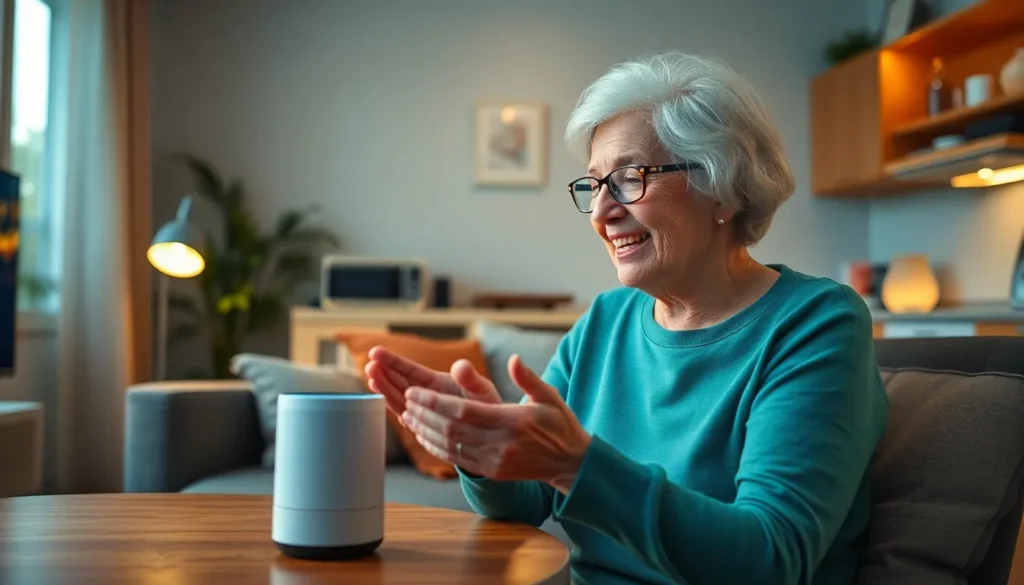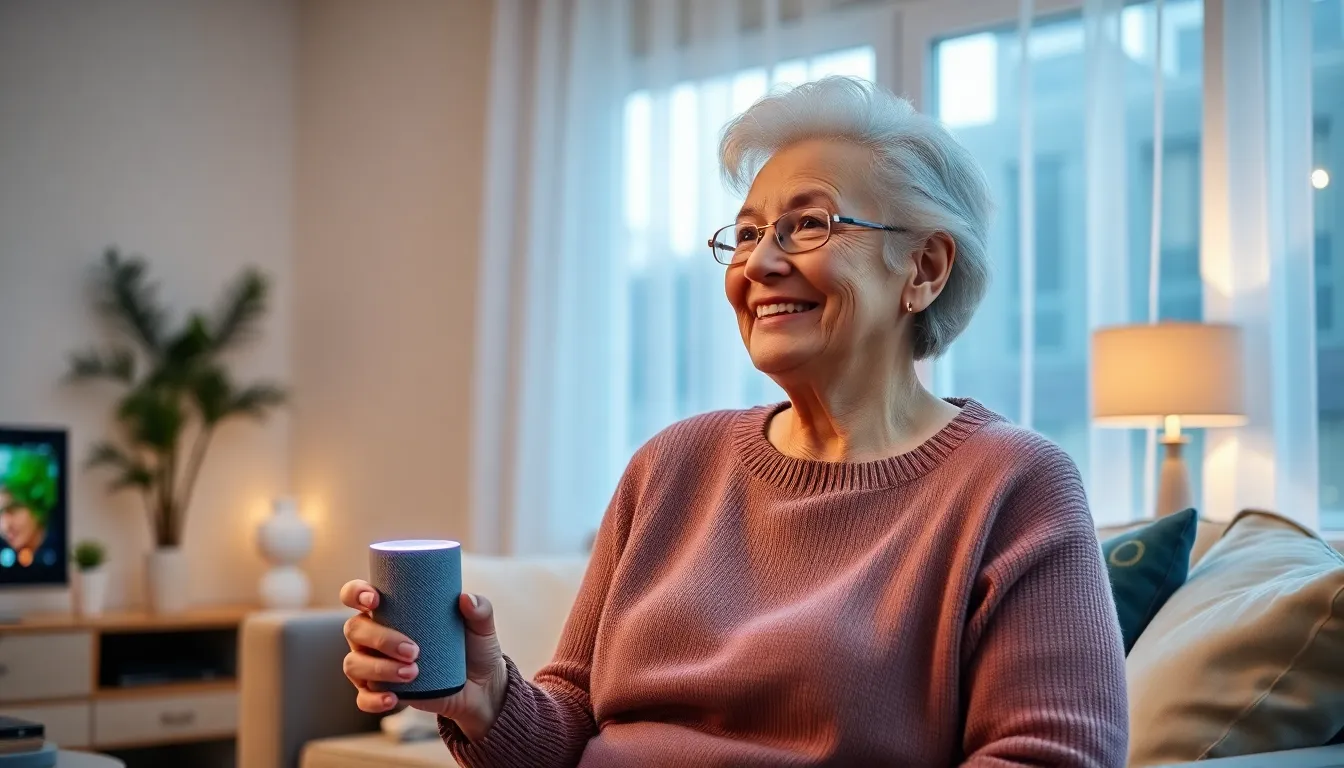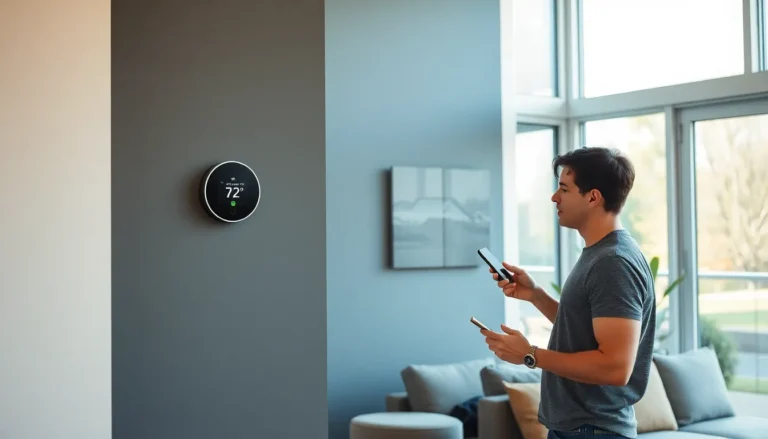Table of Contents
ToggleAs the world zips forward into the future, smart homes are no longer just for tech-savvy millennials. They’re becoming a lifeline for the elderly, transforming everyday living into a seamless experience. Imagine a home that not only remembers your favorite TV shows but also gently reminds you to take your meds—now that’s what we call a win-win!
With smart technology, seniors can enjoy independence while staying safe and connected. From voice-activated assistants that respond to simple commands to smart appliances that can prevent accidents, these innovations are like having a personal assistant who never forgets your birthday. Embracing a smart home isn’t just about convenience; it’s about enhancing quality of life and adding a sprinkle of fun to daily routines. Get ready to explore how these gadgets can turn a regular house into a haven of comfort and security for the elderly.
Overview of Smart Homes for Elderly
Smart homes for the elderly integrate advanced technologies aimed at enhancing everyday life. These homes utilize innovative systems that simplify tasks, ensuring seniors maintain their independence. Features include automated lighting, which responds to movement, and temperature controls that adjust automatically for comfort.
Voice-activated assistants serve as reliable companions, allowing seniors to request information or control devices hands-free. Smart security systems provide peace of mind, with cameras and sensors that monitor entries and exits, ensuring safety. Medical alert devices equipped with fall detection console assistance at the touch of a button.
Home monitoring systems track health data, alerting caregivers to any concerning changes. Smart appliances such as refrigerators can remind seniors of essential tasks like taking medications or grocery shopping. This connectivity fosters communication, enabling seniors to stay in touch with family and friends through video calls or messaging apps.
Community support often complements these technologies, allowing family members to monitor their loved ones from afar. When combined with easy-to-use interfaces, these products reduce frustration for older adults, promoting regular interaction with technology.
The adoption of smart technology can lead to improved health outcomes for elderly individuals. By integrating these systems into their daily lives, seniors can enjoy a higher quality of life, filled with greater comfort and security. As these innovations continue to evolve, they’re shaping a future where aging in place becomes more feasible and desirable for everyone.
Benefits of Smart Homes
Smart homes provide numerous advantages for elderly individuals, significantly impacting their quality of life and daily routines. These technologies enhance safety and offer assistance in a way that promotes independence.
Enhanced Safety Features
Smart homes incorporate various safety features tailored for seniors. Automated lighting ensures well-lit pathways at night, minimizing the risk of falls. Smart security systems enable remote monitoring, allowing caregivers to watch over their loved ones in real-time. Medical alert devices quickly connect seniors to emergency services when necessary. Additionally, door sensors can notify family members if a senior exits their home unexpectedly. Voice-activated technology provides another layer of security, enabling seniors to call for help hands-free. These innovations empower elderly individuals to live with greater peace of mind.
Improved Daily Living Assistance
Daily living becomes easier with smart home technologies. Voice-activated assistants help seniors manage tasks without needing physical interaction. Medication reminders ensure they take prescriptions on time, supporting better health compliance. Smart appliances simplify cooking and cleaning, enhancing overall well-being. Automated temperature controls maintain comfortable living environments throughout the day. Communication tools, such as video calls, foster meaningful connections with family and friends. With these features, smart homes actively improve the daily experiences of elderly individuals, promoting their independence and enhancing their quality of life.
Key Technologies Used
Smart home technologies for the elderly enhance security, independence, and quality of life. Key innovations drive these advancements.
Smart Sensors and Alerts
Smart sensors monitor various conditions in the home. Motion detectors track movement, helping caregivers stay informed about residents’ activities. Leak sensors identify water leaks, preventing potential damage and ensuring safety. Temperature sensors detect extreme heat or cold, alerting users to dangerous conditions. These sensors deliver real-time notifications to caregivers or family members, fostering proactive interventions. With alerts on smartphones, users can respond quickly to any situation, enhancing peace of mind for both seniors and their loved ones.
Voice-Activated Devices
Voice-activated devices facilitate hands-free control over home environments. Technologies like Amazon Echo or Google Home serve as reliable companions for seniors. These devices enable users to adjust lighting, play music, or set reminders with simple voice commands. Accessing information becomes easier with just a few words, supporting seniors’ independence. Sound-activated technology allows for seamless interactions, even for those with mobility challenges. Communication becomes more accessible, enabling seniors to connect with family through voice calls or video chats. Overall, these devices contribute significantly to comfort and convenience in everyday life.
Challenges and Considerations
Seniors face various challenges when integrating smart home technology into their lives. Understanding these barriers is crucial for optimizing their experiences.
Technology Adoption Barriers
Adopting new technology often poses issues for elderly individuals. Limited familiarity with technical devices can lead to frustration. Communication barriers may arise if family members lack the time to share instructions. Physical limitations further complicate technology usage, making simple tasks difficult. According to a 2022 Pew Research study, only 42% of seniors feel confident using modern devices. Training programs that include hands-on assistance significantly improve usability. Providing comprehensive guides in an easily digestible format can help reduce anxiety associated with technology. Overall, addressing these barriers is essential for successful technology integration.
Privacy and Security Concerns
Elderly individuals may have legitimate concerns about privacy and security in a smart home environment. Data breaches and unauthorized access could pose risks to sensitive personal information. Recognizing these fears is vital for encouraging technology adoption. According to a 2023 survey by AARP, 66% of seniors worry about hackers targeting their devices. Ensuring strong encryption and robust security measures can alleviate some of these concerns. Manufacturers can enhance user trust by prioritizing transparent data collection practices. Providing users with options to customize privacy settings also empowers seniors to feel more secure in their homes.
Future of Smart Homes for Elderly
The future of smart homes for the elderly appears promising, with innovations continuously shaping daily living. Advancements are making smart technology more accessible and user-friendly for seniors. Voice-activated systems are steadily enhancing interaction, allowing elderly users to engage with their homes easily. Additionally, automation will expand, enabling integrated solutions for everything from lighting to temperature control.
Smart sensors will play a pivotal role, monitoring home conditions and providing caregivers with critical real-time alerts. Movement detection, environmental changes, and emergency notifications will facilitate proactive care and minimize risks. Furthermore, wearable technology will integrate seamlessly, tracking health metrics and ensuring seniors maintain their well-being with minimal effort.
New partnerships among tech companies, healthcare providers, and community organizations aim to develop tailored solutions. Engaging local resources in training programs will improve adoption rates, ensuring seniors feel confident using these advanced tools. Social integration through video calls and messaging will foster stronger connections with family, combating feelings of isolation.
Nurturing trust in smart technology remains essential. Addressing privacy concerns and enhancing data security measures will build confidence among seniors. A focus on transparency regarding data usage is crucial for promoting widespread acceptance.
As advancements in voice recognition and artificial intelligence continue, the human-like interaction will enhance the usability of smart systems. The collective goal remains: creating an environment that empowers elderly individuals to age in place successfully and comfortably.
Conclusion
Smart home technology is revolutionizing the way elderly individuals live, offering them the independence and safety they deserve. With features designed to simplify daily tasks and enhance communication, seniors can enjoy a better quality of life while staying connected to loved ones.
As technology continues to evolve, it’s crucial to address the barriers that may hinder seniors from fully embracing these innovations. By focusing on user-friendly designs and robust security measures, families and caregivers can help foster a supportive environment for elderly individuals.
The future holds great promise for smart homes, making aging in place not just a possibility but a reality filled with comfort and security. Embracing these advancements will empower seniors to thrive in their own homes for years to come.








